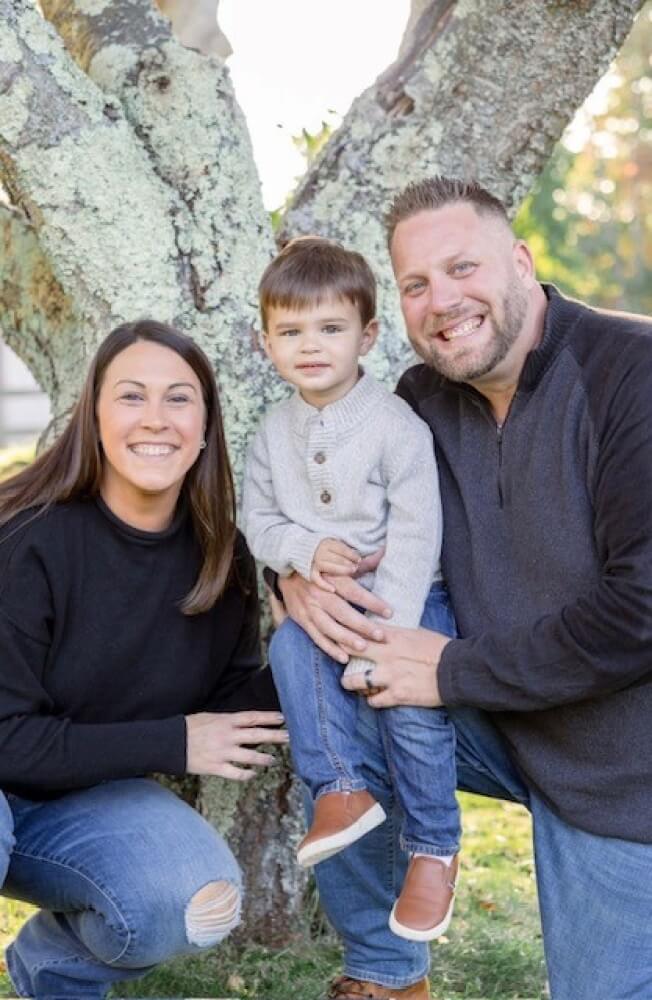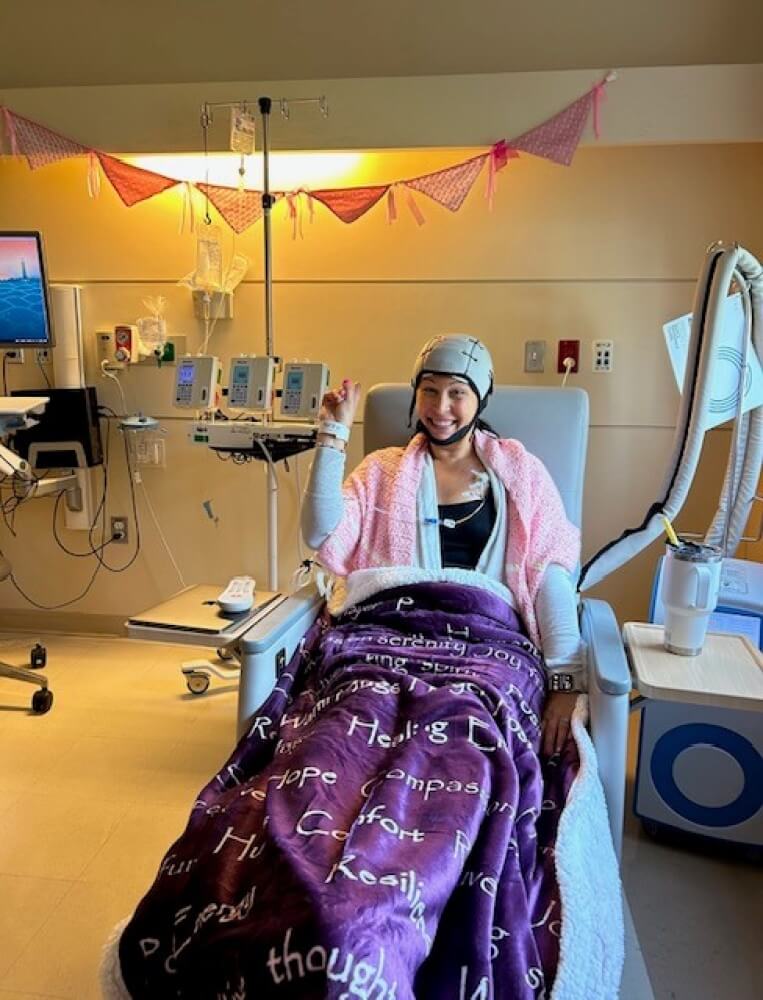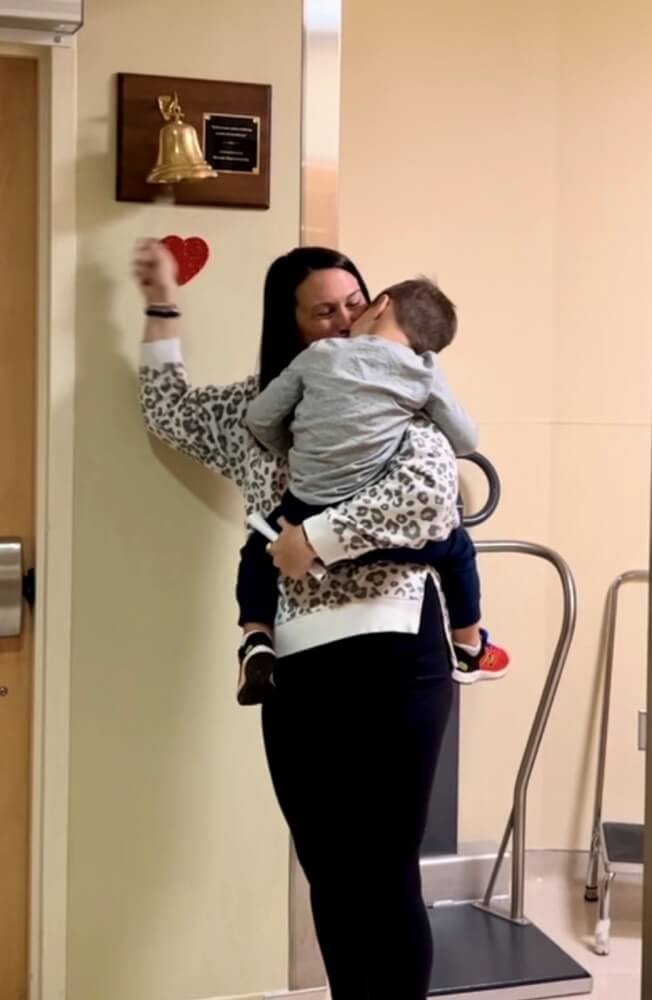Andrea Baxter remembers talking with girlfriends prior to her first mammogram in February 2023, just four months after her 40th birthday.
“We joked about how these routine scans were a sign of getting older,” she recalls. “Nobody thought anything bad would come from them.”
From working in the insurance field, Baxter knew that mammograms — the most effective test for detecting early breast cancer — were covered by most insurance companies starting at age 40 for people of average risk. At the time, however, Baxter says she was not worried about the outcome of her first scan.
“I was healthy, felt great, and had no history of breast cancer in my family,” Baxter explains. “Everybody else’s mammogram went fine, so why shouldn’t mine too?”

In May 2023, abnormal findings from Baxter’s first ever mammogram revealed a diagnosis of HER-2 positive breast cancer, a particularly aggressive form of the disease. After a year of treatment at Dana-Farber Brigham Cancer Center at Milford Regional Medical Center near her home in Upton, Massachusetts, Baxter has a message to share: don’t put off that first mammogram.
“Breast cancer can be traumatic, but people tend to have a better prognosis when it’s caught earlier,” says Baxter. “It doesn’t matter how good you feel, or whether you have any other warning signs. Get one as soon as you can.”
Strong and present
Before her diagnosis, Baxter had experience with cancer when her father was diagnosed with esophageal cancer in late 2019 and cared for at Dana-Farber Brigham by Thomas Abrams, MD. Once Baxter got married and found out she was pregnant, she and her husband, Jeff, moved from Dunstable to Upton in 2021 to be closer to her parents as her father continued his recovery.
While driving near her new home one day, Baxter recalls noticing something that surprised her.
“It was the [Dana-Farber Brigham Cancer Center at Milford Regional Medical Center] campus, just eight minutes from our house,” says Baxter. “I remember thinking to myself, ‘That’s good to know.’”
While shocked by her diagnosis, which came shortly before her and Jeff’s son JJ turned 2, Baxter says she was comforted that she could receive much of her care close to home. She credits her surgeon Faina Nakhlis, MD, oncologist Natalie Sinclair, MD, radiation oncologist Monica Krishnan, MD, and the rest of her clinical team for making her treatment regimen — which consisted of 12 rounds of chemotherapy, 19 radiation treatments, and a year of immunotherapy — as unobtrusive and accommodating as possible to her young family.

“Dr. Sinclair was great about making sure I didn’t spread myself too thin, and that I could be as strong and present for JJ as my treatment allowed,” explains Baxter. “The level of investment that she and the team have in their patients is incredible.”
Sinclair was similarly impressed by Baxter’s attitude towards her diagnosis and treatment.
“From the moment I met Andrea she was very focused and confident in her goals for her care,” says Sinclair. “I was impressed by the level of research and thought she put into her decisions. She asked a lot of hard and insightful questions. As terrifying as it was to think about not being around for her husband and young child, she was able to remain poised and clear and undaunted. She chose a harder treatment overall in every sense of the word than other patients and moved boldly forward and conquered her cancer.”
When faced with the prospect of losing her hair due to chemotherapy, Baxter was especially concerned about the impact it may have on her young son. With guidance from her care team, Baxter decided to try scalp cooling. This treatment narrows the blood vessels beneath the skin of the scalp — which reduces the amount of chemotherapy medicine that reaches the hair follicles and causes hair loss — using a liquid coolant delivered through a machine while the patient wears a tight-fitting silicone cap and an outer cover on their head before, during, and after each infusion.

Jeff was on hand to help with Andrea’s cap fittings and her Milford team, including nurse Christie Carr, BSN, RN, physician assistant Emily Joyal, PA-C, and clinical assistant Violla Duverseau, oversaw the scalp-cooling process. Baxter says she lost just 5% of her hair.
Bright star
Once her chemotherapy and radiation treatments were completed, Baxter still had to complete maintenance therapy with herceptin every three weeks. Sinclair cites this as an example of the benefits of combining HER2 therapy and standard therapy to increase progression-free survival patients with HER2-positive breast cancer.
Baxter was able to complete her year of active treatment even as she experienced fatigue and had a reaction to a chemotherapy drug called Taxol that required her to undergo three of her chemotherapy infusions in the desensitization unit at Dana-Farber Brigham’s Boston campus. This only reinforced her feelings that even if a person feels well, conducts breast self-exams regularly, and shows no other warning signs, mammograms remain the best way to catch breast cancer early at any age.
“Andrea is a bright star whose positive attitude was seen week after week, even when side effects arose,” recalls Carr. “I am in awe of her determination to help educate others on the importance of mammogram screening. She turned her diagnosis into an opportunity to help others – how inspiring and amazing!”

I was diagnosed with stage 2, triple negative breast cancer when I was 53. My first mammogram showed a benign lump and my adventure began. My cancer was found early. Had chemo. No radiation. Double mastectomies, reconstruction. No family history. But I survived. Early detection and surgery kept me going. Never skip a mammogram and never ignore a palpable lump.